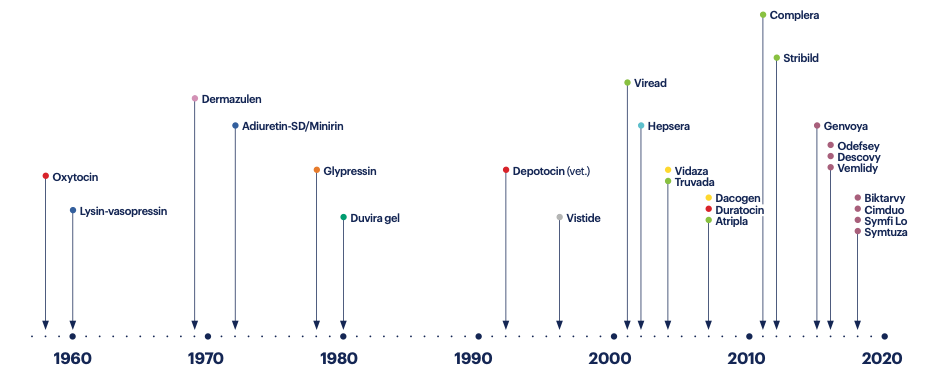Successful IOCB compounds

IOCB has always been active and successful in applied research and practical applications, particularly in medicinal chemistry. The tradition started in 1969 with an ointment called Dermazulen, which was followed by the development of several human peptide hormones and their analogues (lysin-vasopressin, oxytocin).
From a global perspective, the most significant contributions were acyclic nucleoside phosphonate antivirals (especially tenofovir as a component of Truvada, Atripla, and other anti-HIV and anti-HBV drugs, but also cidofovir and adefovir) discovered by Antonín Holý at IOCB and later developed and marketed by Gilead Sciences, Inc.
Besides this well-known antiviral drug story, several other nucleoside compounds developed at IOCB became approved drugs. These include Decitabine, which is used in the treatment of acute myeloid leukemia, Azacytidine, which targets myelodysplastic syndrome (both discovered by Holý’s peer Alois Pískala), and 9-(2,3-dihydroxypropyl)adenine (DHPA), an acyclic nucleoside analogue discovered by Holý and used clinically in anti-herpes ointments.
Peptide hormones and their analogues
Research on biologically active peptides has a long tradition at IOCB. From the 1950s to the 1980s, it mainly focused on establishing the structure-activity relationship in neurohypophyseal hormone analogues and the discovery of analogues with specific biological activity.
Azulens
Guaiazulene is a natural compound known for its healing, anti-inflammatory, and mild disinfectant properties. It has also been used to treat skin damaged by radiotherapy. Large-scale chemical synthesis was developed at IOCB in the 1950s, and Dermazulen ointment was introduced to the market in 1969. It remains a popular drug 50 years later.
Nucleoside analogues
Duvira, 9-[2,3-(dihydroxy)propyl]adenine, is used to treat infections caused by the herpes simplex virus (HSV). Although the drug does not eradicate the virus from the body (no such therapy is known to date), it is active against fever blisters and suppresses virus replication.
Modified nucleosides
Studies on 6-azapyrimidines and 5-azapyrimidines and their nucleosides conducted at IOCB resulted in the discovery of potent antimetabolites. The cytidine analogues 5-azacytidine and 2-deoxy-5-azacytidine were first synthesized, patented, and published by Alois Pískala in the mid-1960s. It would take 40 years to introduce these cytostatics to the market, long after the original patents had expired.
Acyclic nucleoside phosphonates
In early 1980s, Antonín Holý together with Erik De Clercq of the Rega Institute for Medical Research discovered acyclic nucleoside phosphonates (ANPs) with the aim of developing metabolically stable isopolar and isosteric nucleotide analogues. The ANP analogues exhibited a unique spectrum of antiviral and antitumor activity.



